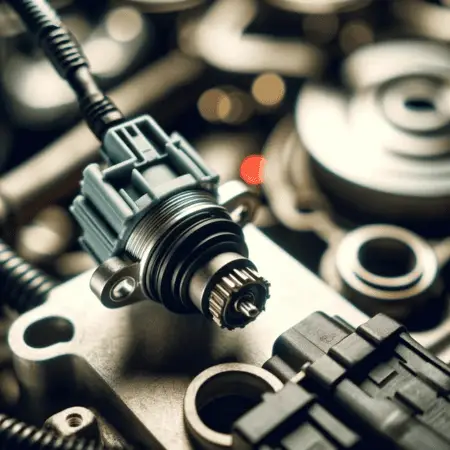You’re all set to go outside, but just as you turn the ignition, you’re met with silence instead of the satisfying purr of your engine. Your car refuses to start, leaving you stranded and scratching your head in frustration. Could it be a dead battery? Faulty wiring? Or perhaps, the elusive culprit – a bad crankshaft sensor? And you are here after diagnosing that that culprit is a bad crankshaft. So keep reading how to start a car with a bad crankshaft sensor.
How To Start A Car With A Bad Crankshaft Sensor? Starting a car with a bad crankshaft sensor can be challenging, and it is not recommended as a long-term solution. However, in some emergencies, you may attempt to start the vehicle with the following steps.
Turn the ignition key to the “On” position without cranking the engine. Wait for a few seconds to allow the fuel pump to pressurize the fuel system. Afterward, turn the key to the “Start” position and crank the engine. If the car fails to start, repeat the process a few times, giving the system brief intervals to reset.
Keep in mind that this is a temporary workaround, and you should seek professional assistance to replace the faulty crankshaft sensor as soon as possible to ensure the proper functioning of the engine and avoid potential damage.

What Is A Crankshaft Sensor?
A crankshaft sensor, also known as a crank position sensor (CPS) or engine speed sensor, is a device used in internal combustion engines to monitor the position and rotational speed of the crankshaft. The crankshaft is a crucial component in the engine that converts the reciprocating motion of the pistons into rotational motion, which ultimately drives the vehicle’s wheels.
The crankshaft sensor detects the precise position of the crankshaft and sends this information to the engine control module (ECM) or engine control unit (ECU). The ECM uses this data to determine the engine’s speed and position, allowing it to optimize various parameters such as fuel injection timing, ignition timing, and other engine functions. This optimization helps improve fuel efficiency, reduce emissions, and enhance overall engine performance.
Symptoms of a bad crankshaft sensor
The telltale signs of a crankshaft sensor gone rogue are like the breadcrumbs that lead you straight to the heart of the problem. When this critical component starts acting up, your car isn’t shy about letting you know something’s amiss. Here are some symptoms to watch out for:
1- Difficulty Starting:
One of the most common indicators of a faulty crankshaft sensor is difficulty starting the engine. You might find yourself turning the key or pressing the start button repeatedly, only to be met with stubborn silence or sluggish cranking. It’s as if your car is playing hard to get, leaving you stranded and scratching your head.
2- Intermittent Stalling:
You’re cruising down the road, enjoying the wind in your hair and the open highway stretching out before you. But suddenly, without warning, your car sputters and stalls, leaving you coasting to a stop on the side of the road. If your vehicle has a habit of stalling out unexpectedly, especially at low speeds or when idling, it could be a sign that the crankshaft sensor is on the fritz.
3- Erratic Engine Behavior:
Your car’s engine is a finely tuned machine, humming along smoothly like a well-oiled symphony. But when the crankshaft sensor decides to throw a wrench in the works, all bets are off. You might notice erratic engine behavior, such as surging, hesitating, or struggling to maintain a consistent speed. It’s as if your engine has a mind of its own, lurching and lunging unpredictably with each press of the accelerator.
4- Unresponsive Tachometer:
The tachometer, or RPM gauge, is like a window into your engine’s soul, giving you a glimpse of its inner workings with each flicker of the needle. But when the crankshaft sensor is on the fritz, the tachometer may become unresponsive or erratic, failing to accurately reflect changes in engine speed. It’s as if your car is keeping its RPMs close to its chest, leaving you in the dark about what’s going on under the hood.
5- Check Engine Light:
Last but not least, the trusty check engine light – that ever-present beacon of automotive distress. When the crankshaft sensor goes haywire, it’s not uncommon for the check engine light to illuminate on your dashboard, signaling that something is amiss. While the check engine light can indicate a wide range of issues, a bad crankshaft sensor is often at the top of the list, especially if accompanied by other symptoms like those mentioned above.

how to start a car with a bad crankshaft sensor
Step 1: Diagnose the Issue:
Before you roll up your sleeves and get to work, it’s crucial to confirm that the crankshaft sensor is indeed the culprit behind your car’s starting woes. When a crankshaft sensor fails, it disrupts the engine’s ability to accurately time fuel injection and ignition, leading to symptoms like difficulty starting the engine, frequent stalling, or erratic engine behavior. Take note of any warning lights on your dashboard and listen for unusual sounds when attempting to start the car.
Step 2: Locate the Sensor:
The crankshaft sensor is typically situated near the bottom of the engine, close to the crankshaft itself. However, its exact placement can vary depending on the make and model of your vehicle.
Step 3: Inspect for Damage:
Once you’ve located the sensor, it’s time to give it a once-over. Check the sensor and its wiring harness for any visible signs of damage, such as frayed wires, corrosion, or loose connections. Over time, exposure to heat, oil, and debris can degrade the sensor and its components, leading to malfunctions. If you notice any issues, try cleaning the sensor and reconnecting it securely to see if that resolves the problem.
Step 4: Give it a Tap:
Sometimes, a little mechanical persuasion can work wonders. If you suspect that the sensor may be stuck or has a loose connection, gently tapping on it with a small tool or your hand could help jostle it back into action.
Step 5: Use Starting Fluid:
It’s time to bring out the big guns when all else fails – starting fluid. This highly flammable aerosol is designed to aid in starting stubborn engines by providing an additional source of ignition. To use starting fluid, locate the air intake duct or throttle body on your engine and carefully spray a small amount of fluid into the intake while someone else attempts to start the engine.
The combustible nature of the fluid can help ignite the fuel mixture, bypassing the need for precise timing from the crankshaft sensor.
Step 6: Jump Start the Car:
If your car still refuses to cooperate, you can try jump-starting it using jumper cables and another vehicle. However, due to the role of the crankshaft sensor in the starting process, a traditional jump start may not always be effective.
Instead, you can try a slightly different approach: connect the positive (+) terminal of the dead battery to the positive terminal of the live battery as usual, but instead of connecting the negative (-) terminal of the dead battery to the negative terminal of the live battery, connect it to a bare metal surface on the engine block of the dead car. This bypasses the electrical system and may provide enough juice to start the engine, albeit temporarily.
If none of the DIY methods yield results or if you’re uncomfortable attempting them yourself, it’s best to seek assistance from a qualified mechanic. In some cases, the crankshaft sensor may need to be replaced or recalibrated to restore proper engine function.
Precautions when Starting car with a bad crankshaft sensor
When dealing with a potentially faulty crankshaft sensor or any automotive issue, it’s essential to exercise caution to ensure your safety and prevent further damage to your vehicle. Here are some precautions to keep in mind:
Safety First:
Before you start tinkering under the hood, make sure your car is parked in a safe and well-ventilated area, preferably on a level surface. Engage the parking brake and, if possible, chock the wheels to prevent the vehicle from rolling.
Disconnect the Battery:
Whenever you’re working on electrical components or sensors in your car, it’s a good idea to disconnect the battery to prevent accidental shocks or short circuits. Locate the battery in your vehicle and remove the negative (-) terminal first, followed by the positive (+) terminal.
Handle Electrical Components with Care:
Crankshaft sensors and other electrical components are sensitive creatures, easily damaged by mishandling or exposure to moisture and debris. When inspecting or replacing the sensor, avoid touching the electrical contacts with your bare hands, and take care not to bend or break any delicate wires.
Use Proper Tools:
Having the right tools for the job can make all the difference when working on your car. Invest in a quality set of wrenches, sockets, and screwdrivers, as well as specialized tools like a multimeter for testing electrical circuits. Using the wrong tool can lead to stripped bolts, broken components, and a whole lot of frustration.
Follow Manufacturer Guidelines:
Every vehicle is unique, so it’s essential to consult your car’s manual or seek guidance from reputable sources when performing maintenance or repairs. Pay close attention to torque specifications, routing of wiring harnesses, and any special procedures recommended by the manufacturer.
Avoid Excessive Force:
When removing or installing components, it’s important to use gentle, controlled force to avoid damaging delicate parts or stripping threads. If a bolt or fastener seems stuck, try applying penetrating oil and allowing it to soak in before attempting to loosen it again.
Double-Check Your Work:
Once you’ve completed the necessary repairs or maintenance, take a moment to double-check your work and ensure everything is properly reassembled and tightened. It’s better to spend a few extra minutes now than to risk a costly mistake or safety hazard later on.
By following these precautions, you can help ensure a smooth and safe experience when diagnosing and addressing issues with your car’s crankshaft sensor or any other component. Remember, when in doubt, don’t hesitate to seek assistance from a qualified mechanic or automotive professional. Your safety is always worth the extra effort.
Further Readings
- What Happens If My Drive Shaft Breaks While Driving?
- How Do I Stop My Brakes From Squeaking In Reverse? ( 6 Steps )
- Drive Start Control Malfunction – Signs & Causes
conclusion
How to start a car with a bad crankshaft sensor? Dealing with a faulty crankshaft sensor can be a frustrating and challenging experience, but armed with knowledge, caution, and the right approach, you can navigate the situation with confidence. By recognizing the symptoms of a bad crankshaft sensor, taking appropriate precautions when working on your vehicle, and following manufacturer guidelines, you can effectively diagnose and address the issue to keep your car running smoothly down the road.
